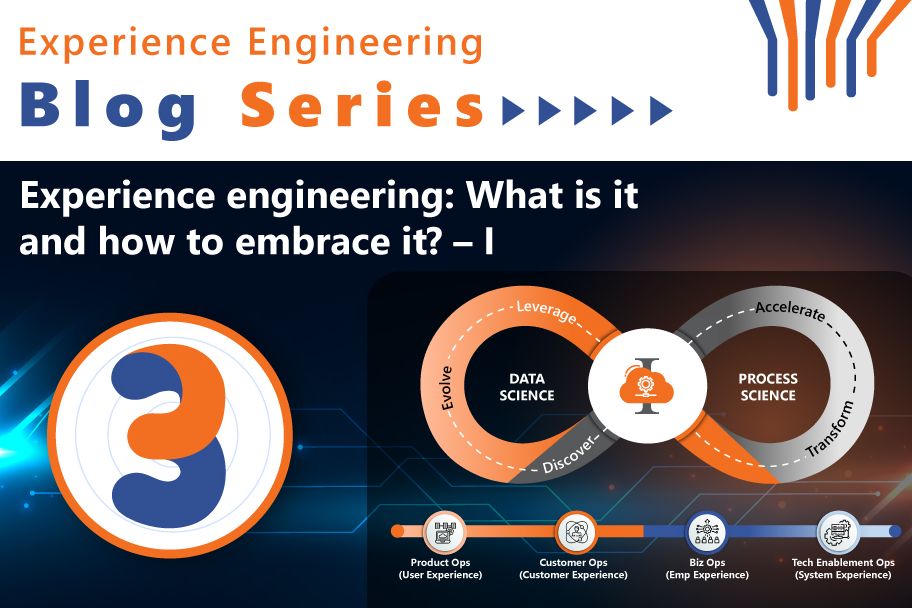Experience Engineering: What is it and how to embrace it? – I
Introduction:
2021 Digital Business Study by Foundry states that “91% of organizations surveyed have adopted or have plans to adopt a digital-first business strategy.” The researchers estimate that companies will spend $16.5 million over next 12 months on “digital initiatives” including AI/ML, Data Analytics and Cloud.
As more business operations are becoming digitized or automated, it’s important to understand how each of the systems used throughout the organization affects one another. Many companies introduce new systems or technologies with the intent of benefitting the workflow and driving greater efficiency, but if they’re not properly integrated into the existing infrastructure this adversely impact the total experience, efficiency, and productivity across the business functions.
The solution to this challenge is Experience Engineering: the action of driving toward the goal of a holistic, integrated digital user experience. The intent is to increase productivity, employee engagement, efficiency, and a satisfied customer experience. But how does experience engineering work towards this goal?
The goal: a simplified digital experience
The underlying goal for businesses is to increase revenue and profit by creating the most efficient and optimized operating model possible. For modern companies, much of this is accomplished through the enhancement and refinement of digital processes. This might involve introducing new software or technology or adjusting how current systems work in relation to one another.
The aim of experience engineering is to truly integrate and streamline the systems within an organization as fully as possible and make them interoperable for seamless experience. The outcome of this process is essentially two-fold:
- Employees will work faster and more effectively, with less stress and greater job satisfaction.
- Customers will benefit from a user-friendly, streamlined digital experience, increasing their satisfaction, and in turn, their likelihood to return to or recommend your business.
In the post pandemic era, as digital becomes the de facto mode of communication and collaboration, companies must create distinct personas for customers and employees to get a clear understanding of the experiences associated with these different “personas” and adopt a structured approach to enable total digital experience.
Adopting a data-driven approach
User Experience (UX) can be quantified using metrics such as user adoption, goal completion, error rate, user retention, average time spent, task completion, and customer satisfaction. These metrics will help us identify where the user experience can be improved and simplified. Through objective analysis, the weaknesses in an organization’s processes can be identified and resolved with the implementation of creative digital solutions.
Experience engineering require organizations to leverage process mining and data discovery tools along with user interviews that empathize, define and ideate an experience-led solution. To summarize, enabling data-driven experience management depends on:
- Data analytics capability embedded with workflow and dataflow sequencing
- Operational platform reengineering with automation and native digital capabilities
Defining & embracing a “digital fabric”
A holistic approach that encompasses all potential digital solutions available is required to fully optimize the digital experience. The goal of experience engineering should be extended from identifying process improvements to building a “digital fabric” that can intertwine legacy platforms with modern solutions for seamless user experience.
Using Robotic Process Automation (RPA), for example, allows greater flexibility but when combined with low-code no-code (LCNC) or sophisticated/specialized workflow orchestrator like Salesforce or ServiceNow or Microsoft Power Platform or Google Workspace/Cloud Platform, it makes the process of adjusting settings and configurations swifter and simpler. It is like build a canal to make the flow of process, data, and experience smoother throughout business functions within an enterprise.
A key aspect of building a well-integrated digital fabric is to improve the digital fluency within an enterprise — the method with which your digital systems connect and work together. This begins with identifying all experience layers across your business and establishing how each is linked to systems via workflows. Determining this complete view of your business is the first step in establishing where embedded technologies such as AI and analytics can be used to enhance the quality of experience for employees and customers.
Application Programming Interfaces (APIs) can be leveraged to connect systems that have limitations in terms of synchronizations and data exchange.
Building an integrated “digital workbench” solution is key to gain a complete understanding of all the users workflow and the systems currently in use to complete a business function benefiting customers and internal stakeholders. A digital workbench solution will provide necessary insight into operations across customer, employee, and product experiences to track, monitor and trigger workflows by using data analytics and advanced AI.
Key components of digital workbench:
- Task Automation – From simple rule-based automation to AI-powered Intelligent Automation for enhancing employee experience.
- Analytics and Decision Making – Leverage data mining, observability, and data governance for better data flow within the organization.
- AI-Powered Transformation – Analyze data to identify patterns and learn from past actions to automate tasks, processes and workflows leading to better digital experiences.
- Design Thinking, Product Mindset and UX Focus for superior product experience.
- Process Workflows – process mining to prioritize and optimize different processes
Way Forward:
Thus far, we at iOPEX have covered the steps required to lay a strong foundation for achieving a total experience and how defining a digital fabric and choosing the right technology act as prerequisites to achieve the digital objectives of an organization. Once a company has clarity on digital goals, the way forward is to develop a risk-free implementation roadmap. Read part four of the blog series where we elaborate how to develop a roadmap and action plan.











